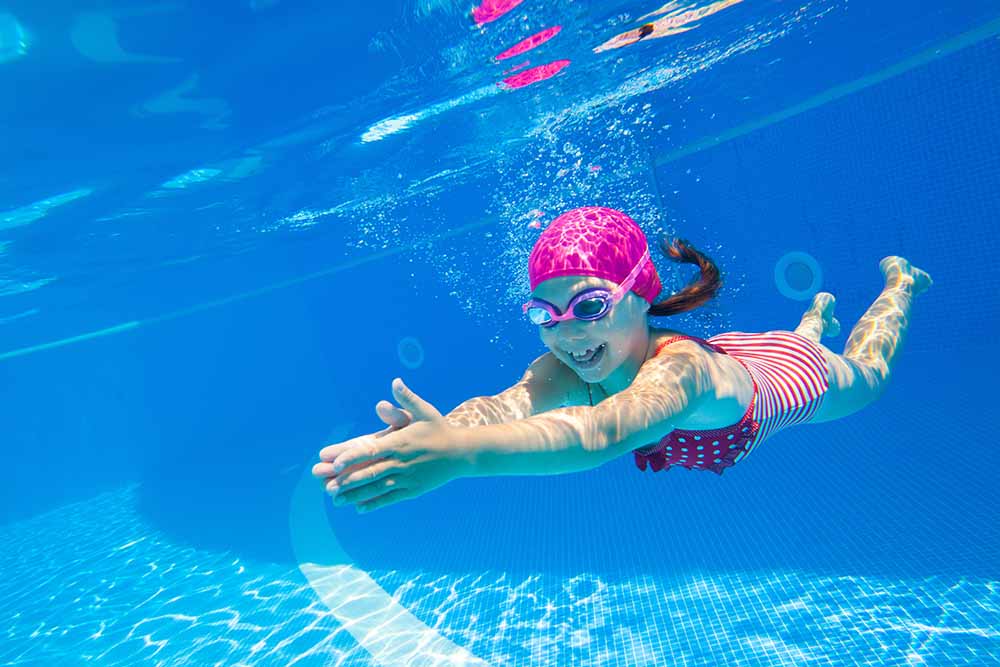Infections from Swimming Pools

As the weather warms up, children, along with us, frequently swim in pools. Do you know what dangers might be lurking in many pools and what precautions to take before letting your child swim?
Diarrhea
If the pool you swim in is contaminated with microorganisms that cause diarrhea, even a small amount of swallowed water can lead to diarrhea. Even if someone has had diarrhea in the past two weeks, they can spread germs through water when they enter the pool.
The most common microorganisms causing diarrhea are Cryptosporidium, Giardia, Shigella, norovirus, and E. coli. Cryptosporidium, which is the most common cause of pool-related diarrhea outbreaks, can survive for days in pools cleaned with chlorine and other chemicals. Therefore, it is important to shower before entering public pools. It is particularly advisable to avoid crowded pools with questionable cleanliness. Similarly, rivers and ponds can also be dangerous for this microorganism.
Diarrhea transmitted through water can last up to three weeks and may lead to severe, sometimes life-threatening dehydration.
When should you go to the hospital if your child has diarrhea while on vacation?
– If the diarrhea is bloody,
– If it lasts longer than 5 days,
– If accompanied by fever and chills,
– If there are signs of dehydration (dry mouth, cracked lips, headache, confusion, or decreased urine output), you should definitely visit the hospital.
Urinary Tract Infection
One of the most common infections during the swimming pool season is a urinary tract infection (UTI). The infection occurs when bacteria invade the urethra and bladder. These bacteria can be transmitted from pool water or sitting on a damp swimsuit.
Symptoms suggesting a UTI include:
– Painful urination,
– Cloudy urine,
– Blood in urine,
– Pain in the groin or anal area,
– In infants, symptoms such as irritability, vomiting, and refusal to eat.
To prevent UTIs, shower after swimming, change out of wet clothes as soon as possible, and drink plenty of water. Antibiotics may be needed for treatment.
Rashes/Redness
Water contaminated with Pseudomonas Aeruginosa bacteria, especially in hot tubs, can cause skin irritation and redness. Chlorine and other disinfectants break down faster in hot water, making hot tubs and jacuzzis higher risk. However, this bacteria can also be found in poorly maintained pools or polluted rivers and ponds.
The longer your skin is exposed to contaminated water, the higher the chance of developing a rash or redness. Sometimes you might think you are clean after coming out of chlorinated water, but the safest thing is to shower as soon as possible after leaving the pool. Additionally, you can ask whether the pool is checked for proper disinfectant and pH levels at least twice a day or use pool and jacuzzi test strips to check the water yourself.
Rashes, typically appearing as itchy, red, uneven spots or pus-filled blisters, usually resolve on their own within a few days. If the rash persists longer, consult a doctor.
Swimmer’s Ear
The medical term for swimmer’s ear is otitis externa (outer ear canal infection). It occurs when water gets trapped in the external ear canal, leading to the growth of bacteria or fungi, and is more common in the summer months. It is more prevalent in children than adults and can cause itching, pain, and swelling in the ear. In some cases, there may be discharge from the ear. If you suspect you have swimmer’s ear, see a doctor; antibiotics may be needed for treatment.
To protect yourself, dry your ears thoroughly with a soft towel after swimming. You can also tilt your head from side to side and gently pull on your earlobe to help drain water from the ear canal.
Effects of Pool Chemicals
Pools typically use three types of chemicals:
– Disinfectants (such as chlorine) to kill bacteria,
– pH adjusters (acids or bases),
– Algaecides.
The goal is to maintain a pH between 7.2 and 7.8, and this needs to be tested regularly.
If pool water is too acidic, it can cause skin and eye irritation. It can also lead to corrosion in the pool’s plumbing and damage to the walls.
If the water is too alkaline, it can become cloudy. Microorganisms like Cryptosporidium, Giardia, Shigella, norovirus, and E. coli are frequently seen in public pools with low chlorine and pH levels.
Chlorine Smell Does Not Mean a Pool Is Clean
A properly cleaned pool should have no odor. Chlorine in pool water combines with substances from swimmers’ bodies, such as dirt, body oils, sweat, urine, and feces, to form chloramines, which are irritating chemicals. It is these chloramines that create the strong chemical smell and cause eye irritation, not the chlorine itself. If you smell this strong odor, it indicates that the pool water is dirty and that chlorine and pH levels need to be tested. High levels of chloramines can irritate your eyes, skin, and nose.
Additionally, adding more chlorine to clean the pool is not the solution. Chlorine should be added in moderation; otherwise, it can harm swimmers. Improperly chlorinated water increases the risk of dermatitis, skin infections, and redness.









